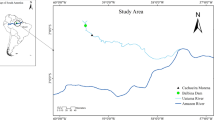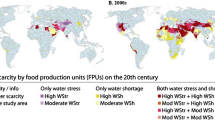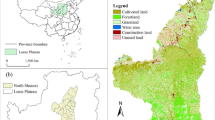Abstract
The purpose of this study was to develop a model for assessing the ecological value of a dam reservoir. Various evaluable characteristics (“elements”) that influence the ecology of the target area around the dam were grouped into three classes: (1) physical elements, such as altitude, slope, and aspect; (2) vegetation elements, such as forest physiognomy, vegetation type, age class, diameter at breast height (DBH) class, and density; and (3) habitat elements, such as ecological conditions, vegetation conservation classification, and frequency of wildlife appearances. The evaluation standard was quantified considering the ecological function of each element. The developed assessment model was applied to the Yeongju Dam in the Nakdong River basin in Korea. This study assumed that the ecological condition before the dam construction was 100 %. The results of this study showed that the physical, vegetation, and habitat elements were downgraded to 82.8, 95.5, and 90.7 %, respectively, after the construction of the dam. The overall ecological value was estimated to be 90.0 % and thus decreased by 10.0 % due to dam construction. Additionally, by combining the results for the evaluation elements, an ecologically healthy area was selected. The results of this study should prove useful for quantifying ecological impact and for establishing an ecological restoration plan for dam reservoirs.








Similar content being viewed by others
References
Bergkamp G, McCartney M, Dugan P, McNeely J, Acreman M (2000) Dams, ecosystem functions and environmental restoration. WCD thematic review—environmental issues II.1. Final report to the World Commission on Dams. Secretariat of the World Commission on Dams, Cape Town
Chen S, Chen B, Su M (2011) The cumulative effects of dam project on river ecosystem based on multi-scale ecological network analysis. Procedia Env Sci 5:12–17
Gangwon-do (2011) A study on ways of restoring riverine in Hangang watershed, Gangwon-do, Korea (in Korean)
Harada J (2002) Conservation and improvement of the natural environment in reservoir watersheds in Japan. Water Resour Dev 18(4):595–610
Harada J, Yasuda N (2004) Conservation and improvement of the environment in dam reservoirs. Water Resour Dev 20(1):77–96
Instream Flow and Aquatic Systems Group (1986) Development and evaluation of habitat suitability criteria for use in the instream flow incremental methodology: biologic report. Instream Flow information paper no. 21. National Ecology Center, Fort Collins
Jang RI (2008) Ecological landscape evaluation compared by visual aspect through GIS overlaying—a case study on Chonbuk Buan-Dam watershed. M.S. dissertation. Chonbuk University, Jeonju (in Korean)
Kang HS, Lee YS, Jeon SH (2011) A study on the evaluation method of ecologically fragmented section for restoration of the riverine ecobelt. J Korean Soc Civil Eng 31(4):383–391 (in Korean)
Kim YJ, Jo YH, Kim KM (2000) Development of the mapping method for urban ecological map for Seoul using natural environment management GIS. J GIS Assoc Korea 8(1):51–67 (in Korean)
Kim DG, Shin HK, Kim JG, Kim HS, Yoo BK, Ahn KS, Jang SW (2011) Functional assessment of Yongdam Dam-wetland by HGM. J Wetl Res 13(3):665–675
Koo B (2004) Ecological conservation and restoration strategies on construction and management projects—focused on dam projects. J Korean Soc Restor Reveg Technol 7(3):1–13
Korea Environment Institute (2003) Case studies for management of environment-friendly dams. Korea Environment Institute, Daejeon (in Korean)
Korea Water Resource Corporation (1997) A guideline on environment-friendly design. Korea Water Resource Corporation, Daejeon (in Korean)
Lee DK, Song WK (2008) A study on the analytic unit of habitat suitability assessment and selection in conservation areas for Leopard Cat (Prionailurus bengalensis)—focus on Chungcheong Province Area. J Korean Inst Landsc Archit 36(5):64–72 (in Korean)
Lim HJ, Lee MW (2011) Prior eco-preserve zoning through stream ecosystem evaluation on dam basin—a case of Yongdam-Dam watershed, Jeollabukdo province. J Korean Inst Landsc Archi 39(2):103–112 (in Korean)
McHarg IL (1969) Design with nature. Natural History Press, New York
Ministry of Environment (MOE) (2002) The implementation of the riparian buffer zone in the Nakdong River (notification no. 2002-140). Ministry of Environment, Sejong City (in Korean)
Ministry of Environment and National Institute of Environmental Research (MOE and NIER) (2006) The guideline of 2nd Korean Nationwide Survey on Natural Environments. Ministry of Environment and National Institute of Environmental Research, Seoul
Ministry of Environment and National Institute of Environmental Research (MOE and NIER) (2012) The guideline of 3rd Korean Nationwide Survey on Natural Environments. Ministry of Environment and National Institute of Environmental Research, Seoul, Korea
Petts GE (1984) Impounded rivers. Wiley, Chichester
Sagong JH, Na JH, Jung OS (2011) Earmarking the areas in which wildlife exist as ecologically connected areas requiring preferential preservation. J Korean Inst Landsc Archi 39(1):106–116
Acknowledgments
This work forms part of the KEI research report “Dam ecological value evaluation and ecological restoration model development,” supported by K-water. This work was also supported by the development of climate change policy supporting model for impact assessment and adaptation planning (Korea Ministry of Environment, project number: 2014001310005).
Author information
Authors and Affiliations
Corresponding author
Rights and permissions
About this article
Cite this article
Kang, H., Jung, S.H. & Park, D. Development of an ecological impact assessment model for dam construction. Landscape Ecol Eng 13, 15–31 (2017). https://doi.org/10.1007/s11355-015-0287-x
Received:
Revised:
Accepted:
Published:
Issue Date:
DOI: https://doi.org/10.1007/s11355-015-0287-x




